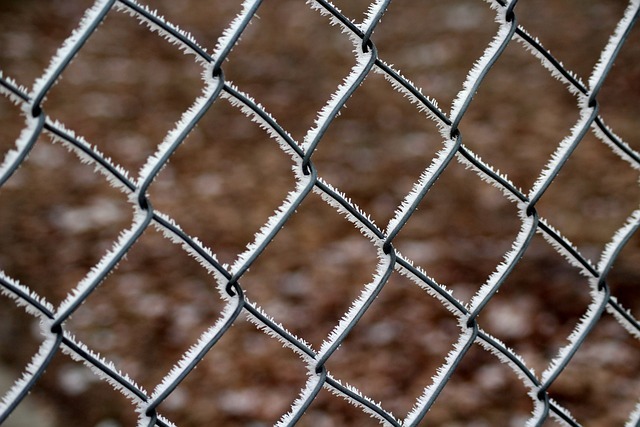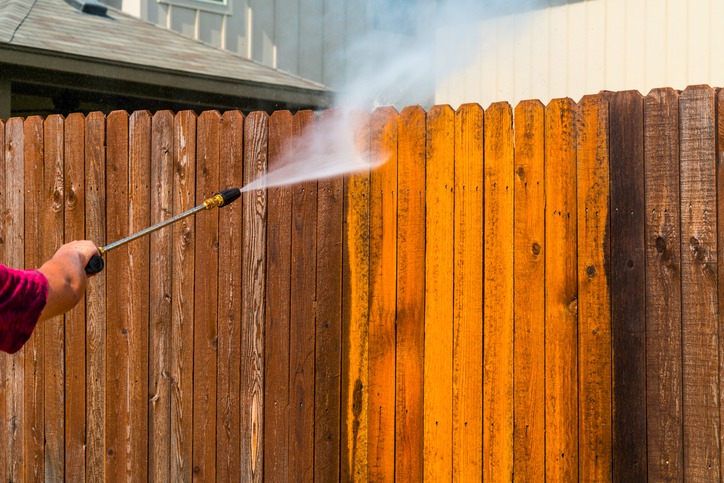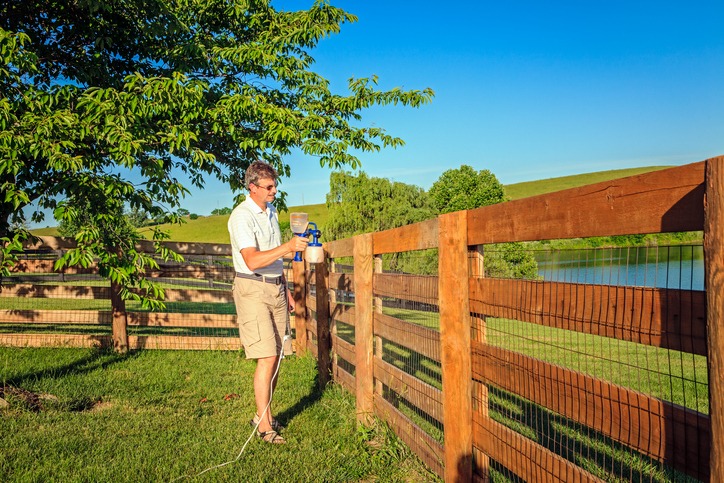Preparing your fence for winter starts with a thorough inspection. Check it for stability, decay, or insect damage, especially looking at gates and hardware. Next, clean off any debris and wash with mild detergent to maintain its appearance and integrity. Trim close vegetation to prevent damage and guarantee good airflow. Don’t skip on timely repairs; fix any damage early to avoid bigger issues. Seal wood fences and keep snow buildup at bay to protect from moisture and ice damage.
Remember, well-oiled hinges make for smoothly operating gates. You’ll have fewer winter woes by getting ahead. There’s more to discover on ensuring your fence stands strong against the cold.
Key Takeaways
- Inspect fences for stability, decay, and insect infestation before winter hits.
- Clean the fence of debris and wash with mild detergent to prevent decay and maintain integrity.
- Apply a water-repellent sealant and ensure efficient drainage to protect against moisture and ice damage.
- Conduct timely repairs and seal or paint wood fences to prevent weather-related damage.
- Regularly inspect and maintain gate hinges, locks, and ensure proper snow removal around the fence for winter resilience.
Initial Fence Inspection
Before winter sets in, it’s vital to carry out an initial fence inspection, searching for any damage like loose boards, rust, or rot to ensure your fence’s durability against the harsh weather ahead. You’ve got to make certain that every part of your fence is up to par. This means giving it a thorough once-over, not just a cursory glance.
Start with the basics: examine the posts for stability. They’re the backbone of your fence, after all. Give them a good shake to see if they wobble. If they do, it’s a red flag. Check for signs of decay or insect infestation too. These issues can weaken your fence’s structure, making it more vulnerable to damage during storms.
Next, don’t overlook the gates and hardware. These components are essential for maintaining access and security. Inspect gates to ensure they swing or slide smoothly and that latches and hinges are in good working condition. Any indication of damage here can lead to bigger problems down the line.
Lastly, look for any leaning or sagging sections. These are telltale signs your fence might not withstand the winter’s fury. Addressing these issues now can save you a heap of trouble when the cold weather hits.
Pre-Winter Cleaning
Starting pre-winter cleaning, you’ll want to begin by removing any debris that could cause decay or invite pests to your fence. This initial step is essential in protecting your barrier against the harsh winter elements. Next, grab a bucket of mild detergent and give your fence a thorough wash. This not only preserves its appearance but also its integrity, ensuring it remains strong against winter’s challenges.
Don’t forget the greenery! Trimming back vegetation that’s too close to your fence promotes good airflow and prevents potential damage. Overhanging branches and invasive plants can compromise your fence’s stability, so keeping them at bay is key.
Inspecting drainage around your fence is another crucial step. You’ll want to make sure water flows freely away from your fence to prevent any water damage. Lastly, cleaning fence accessories and decorative elements is not just about aesthetics; it’s about maintaining functionality.
| Task | Purpose |
|---|---|
| Remove debris | Prevent rot and pest infestation |
| Wash with mild detergent | Maintain appearance and integrity |
| Trim vegetation | Prevent damage and promote airflow |
Timely Repairs Implementation
Now that you’ve cleaned your fence, it’s essential to spot any common damage early. We’ll guide you through effective repair methods and discuss preventive measures to keep your fence robust post-repair. This proactive approach guarantees your fence stands strong through winter and beyond.
Identifying Common Damage
Identifying your fence’s common damage signs, like loose boards, rust, and rot, is important for timely repairs to maintain its integrity. As winter approaches, the risk of damage increases, making regular inspections vital to prevent water damage and further deterioration. Here’s what you should keep an eye out for:
- Loose boards or panels that can lead to structural instability.
- Rust on metal components, which compromises the fence’s strength.
- Signs of decay or insect infestation in wooden fences that can cause extensive damage.
- Malfunctioning gates and hardware that could become problematic during harsh winter conditions.
Addressing these issues promptly guarantees your fence remains stable, functional, and attractive throughout the winter and beyond.
Repair Methods Overview
Implementing timely repairs can greatly reduce the risk of your fence suffering major damage during the winter months. By fixing loose boards, nails, or screws as soon as they’re noticed, you guarantee your fence maintains stability even in harsh weather. Don’t wait until the cold sets in to address weakened areas. Reinforcing these spots beforehand can save you from costly repairs down the line. Regular inspections are key to catching these issues early. Immediate action not only helps maintain the structural integrity of your fence but also prolongs its lifespan. Remember, implementing repair methods promptly isn’t just about fixing what’s broken; it’s about preventing future problems and saving on repair costs through timely repairs.
Preventive Measures Post-Repair
After completing timely repairs, it’s important to adopt preventive measures to shield your fence from winter’s harsh elements. These steps are essential for maintaining the structure’s integrity and prolonging its lifespan, especially for a wood fence that’s vulnerable to the season’s challenges.
Here are the recommended preventive measures:
- Seal or paint the wood fence to create a barrier against moisture and snow build-up.
- Inspect regularly for signs of wear or damage, especially after severe weather events.
- Clear snow build-up promptly to prevent weight and moisture damage.
- Install additional supports if needed, to reinforce the fence against heavy snow and strong winds.
Taking these actions immediately after repairs can significantly reduce the risk of winter damage, ensuring your fence remains secure and aesthetically pleasing throughout the season.
Moisture and Ice Protection
To shield your fence from winter’s harsh elements, it’s important to focus on moisture and ice protection. Applying a high-quality water-repellent sealant is your first line of defense. This step is critical in preparing your fence for winter, ensuring it withstands the season’s moisture without succumbing to damage. The sealant acts as a barrier, repelling water and preventing absorption that could lead to rot or decay in wood fences.
Moreover, diligent snow removal near your fence is crucial. Allowing snow to accumulate can cause structural damage as the weight increases, and as it melts, the risk of water damage rises. This is where your efforts in prevention pay off, safeguarding your fence’s integrity.
Be cautious with ice melt products; while they’re effective at preventing ice buildup, some chemicals can harm the fence material. Opt for safer alternatives that won’t degrade your fence over time.
Additionally, insulating any nearby pipes can prevent water damage and freezing that might impact your fence. Finally, keeping an eye on drainage areas around your fence is essential. Ensuring water flows away efficiently will prevent pooling and freezing, further protecting your fence’s condition through the winter months.
Gate Maintenance Checks
As you get your fence ready for winter, don’t forget about your gate’s requirements. Consistently examine hinges, lubricate all mobile components, and look for any weather-related harm to guarantee smooth operation and security. These basic steps can prevent expensive repairs and prolong the lifespan of your gate during the harsh winter months.
Inspect Hinges Regularly
To guarantee your gate’s longevity, regularly examine and maintain its hinges for peak performance. As part of your fence maintenance routine, it’s vital to inspect hinges to prevent rust and make sure your gate functions smoothly. Here’s what to look out for:
- Check for signs of wear or damage on the hinges that might impact functionality.
- Tighten loose hinge screws to keep the gate properly aligned and stable.
- Examine hinge pins for wear; replace them if needed to prevent gate sagging.
- Ensure hinges are firmly attached to the fence posts, preventing misalignment or unwanted swinging.
Lubricate Moving Parts
Following your regular inspection of hinges, it’s time to focus on lubricating all moving parts of your gate to maintain smooth operation throughout the winter. Utilize a silicone-based lubricant, designed specifically for outdoor use, to protect your fence gates against rust and make sure they work seamlessly even in cold weather. Regularly applying lubricant not only reduces friction but also prolongs the lifespan of your gates, preventing those annoying squeaking noises. Don’t forget to check and lubricate the gate locks too, guaranteeing they continue to function properly as the temperature drops.
| Step | Benefit |
|---|---|
| Lubricate Hinges | Prevents rust, guarantees smooth operation |
| Use Silicone Lubricant | Designed for outdoor, extends gate life |
| Lubricate Locks | Ensures lock functionality in cold weather |
| Regular Application | Reduces friction, prevents squeaks |
This simple maintenance task will keep your fence gates in top condition, ready to face the winter months ahead.
Check for Weather Damage
Examining your gate for weather damage should be a top priority, verifying for any signs of rust, wear, and guaranteeing it aligns properly for secure closure. Getting your gate ready for winter involves a few critical steps to make sure it remains functional and secure throughout the colder months. Here’s what you need to focus on:
- Inspect gate hinges for signs of rust or wear.
- Check gate alignment to make certain it closes properly and securely.
- Lubricate gate locks and hinges to prevent sticking or freezing.
- Look for any damage on the gate, such as cracks or warping.
Taking these steps helps safeguard your property by maintaining the gate’s integrity and functionality, ensuring it withstands the harsh winter weather.
Winter Surveillance Plan
To keep your fence in top condition through the winter, it’s vital to adopt a regular surveillance plan that targets potential damage from snow, ice, and water. Preparing your fence for the harsh elements means you’ll need to inspect your fence regularly for signs of snow accumulation, ice buildup, or water damage. These inspections are essential, especially after heavy snowfalls or strong winds, to guarantee your fence’s stability isn’t compromised.
Pay close attention to gates, hinges, and locks during these checks. They’re indispensable for maintaining smooth operation and security throughout the winter months. It’s not just about the fence itself; you must also monitor the area around it. Proper drainage is key to prevent water pooling at the fence base, which could lead to significant damage over time.
Post-Winter Assessment
Once winter’s grip loosens, it’s crucial you evaluate your fence for any storm-induced wear or damage. Winter fence maintenance doesn’t end when the snow melts; it’s time for a thorough post-winter assessment to guarantee your fence’s longevity. Carefully inspecting your fence can save you from costly repairs and maintain its structural integrity.
Here are some key steps to perform:
- Check for loose boards or posts: These can result from heavy winds or the weight of snow and ice.
- Inspect the stability of the fence posts: Thawing and freezing soil can shift posts, compromising your fence’s stability.
- Look for signs of rot or insect infestation: Wet conditions may have encouraged these issues, especially in wooden fences.
- Evaluate the condition of gates and hardware: Winter’s harsh conditions can damage latches, hinges, and other hardware components.
This assessment isn’t just about fixing what’s broken; it’s about preventing future issues. Proper snow and ice management during winter and a detailed inspection afterward can greatly extend the life of your fence, ensuring it remains a sturdy boundary and attractive feature of your property.
Frequently Asked Questions
How Do I Prepare My Fence for Winter?
To prepare your fence for winter, inspect for frost damage, clean it, and manage vegetation clearance. Address repairs, seal wood, and prevent snow accumulation. Don’t forget to winterize gates, ensuring they’re properly aligned and lubricated.
How Do You Weather Treat a Wood Fence?
To weather treat your wood fence, start with cleaning methods that eliminate debris. Then, apply a water-repellent sealant for moisture prevention. Regularly inspect and uphold the sealant. This routine guarantees your fence withstands the elements.
Can You Seal a Fence in Cold Weather?
Yes, you can seal a fence in cold weather. Choose a low-temperature sealant, apply it carefully, and allow extra drying time due to temperature implications. Proper application techniques guarantee your fence withstands winter’s harsh conditions.
What Do You Put on a Wood Fence to Protect It?
To protect your wood fence, apply a high-quality sealant that acts as a moisture barrier. Consider stain options that include pest deterrents. This not only preserves your fence but keeps pests at bay too.
Conclusion
As winter approaches, it’s vital you’ve inspected, cleaned, and repaired your fence. Protecting it from moisture and ice is essential to avoid damage. Don’t forget to check your gates and establish a winter surveillance plan. Once winter’s grip loosens, assess any damages promptly. By following these steps, you’ll guarantee your fence stands strong against the cold, safeguarding your property while maintaining its aesthetic appeal. Remember, a little effort now can save you a lot of trouble later.




